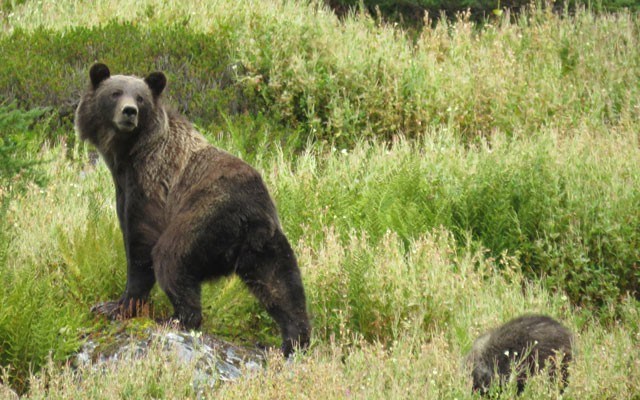Richard MacKellar has lived in Squamish for 19 years, and up until last year he had never seen a grizzly bear in the area.
He's now seen at least three — one last year, and just recently, a mother with one, possibly two cubs, not far from Whistler where he was hiking with his family and relatives from England.
"To have people visiting from England... and see a bear like this was very unique and very exciting," said MacKellar.
It's also very exciting for the Coast to Cascades Grizzly Bear Initiative, which has been working together to recover threatened grizzly bears in southwest British Columbia. The Sea to Sky corridor is the southern line of extirpation for grizzlies. It's one of the reasons why people are banding together to help the threatened populations here.
"I think as our trail network expands in Sea to Sky, we're seeing new trails being built into the alpine on a regular basis... and as the grizzly bear population slowly, slowly comes back, we'll probably have more sightings like this," said Johnny Mikes, field coordinator for Coast to Cascades. "It's part of the wilderness experience in British Columbia."
On Saturday, Aug. 22 MacKellar was one of a party of seven, hiking about 15 kilometres, as the crow flies, outside of Whistler. They were in an area west of Highway 99. The hike is in the Squamish Lillooet grizzly bear population unit, one of five that forms a contiguous link in the southwest; all are deemed "threatened" for the grizzly populations. It is estimated that there are 59 bears in the Squamish Lillooet unit.
MacKellar is keeping the location of his hike "mum," but said it was more remote than hiking the Chief, or Gardibaldi Park or Singing Pass — but it wasn't too far off the beaten path either.
"We came around a corner and right there, less than 200 metres away probably, up on a hillside, there was a mother grizzly — no question it was a grizzly — with a cub, and it was wandering along... We made a little noise and she turned and looked straight into the camera.
"And then she carried on ambling up the hillside, not particularly concerned."
One of her cubs, if there was more than one, began to venture down the hill; the mother called out to it and it quickly changed direction.
MacKellar's hiking party changed its direction to avoid carrying on past her, giving her more space.
Mikes agrees with keeping the location secret.
"Nobody wants a ton of people flocking up to where the bears are," he said. "At this time of year she's trying to put on fat to take her and her babies through the winter time. And we don't want people going there and scaring her away."
As for warning hikers about grizzlies in the area he said: "Their actions should be the same whether they know there's a bear in the area or they don't. They should be taking the same precautions and travelling smart."
While the experience was exciting, MacKellar said it was also a little nerve-wracking — "...a little concerning in that (a grizzly) can cover a couple of hundred metres in a matter of seconds," he added.
What makes the sighting even more exciting is the fact that it was a mother bear.
"The fact that there was one or two cubs with her is great news," said Mikes. "That's exactly what we want to see. It's all about the females — the girls producing cubs so that the population can come back. Every female grizzly bear is really, really valuable."
Mikes was hiking too this past weekend in the one of the tributaries of the Upper Bridge River Valley, in the nearby threatened population unit of the South Chilcotin Range with its estimated 203 bears.
He too saw a mother and two cubs and said: "Seeing the three bears helped make the weekend something special."
For more information on the Coast to Cascade Grizzly Bear Initiative, check out www.coasttocascades.org. If you see a grizzly bear report it at: 1-855-GO-GRIZZ.




